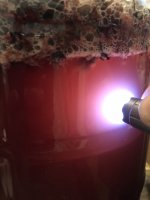WanderingNunican
Member
- Joined
- Jul 19, 2021
- Messages
- 24
- Reaction score
- 23
So I did an extract kit three weeks ago and it is decent. I took those learnings and studied hard and was able to brew my first all grain beer last night.
I don’t have great equipment at this time, just a brew keggle and turkey frier but I made up for it with determination (and a few homebrews).
long story short, I inverted a 55gal trash bin over my keggle, thus making it into a cooler. Temp dropped from 153 after grain add to 145 in 32 minutes. I reheated slowly (15 min), then covered again for 20 min. Final temp was 145.
I used distilled water built with gypsum and calcium chloride
5lb white wheat
6lb pale 2-row
1oz saaz 3.2% - 60 min bittering
1 oz simcoe 13.6% - 5min aromatic/flavor
1.035 pre boil
1.042 post boil (not the best convo)
adjusted ph to 5.6 with baking soda.
The wort tasted so good I could drink it by the glass.
pitched dry K97 in aerated wort.
12 hours into fermentation and we are almost to the blowoff tube!



I don’t have great equipment at this time, just a brew keggle and turkey frier but I made up for it with determination (and a few homebrews).
long story short, I inverted a 55gal trash bin over my keggle, thus making it into a cooler. Temp dropped from 153 after grain add to 145 in 32 minutes. I reheated slowly (15 min), then covered again for 20 min. Final temp was 145.
I used distilled water built with gypsum and calcium chloride
5lb white wheat
6lb pale 2-row
1oz saaz 3.2% - 60 min bittering
1 oz simcoe 13.6% - 5min aromatic/flavor
1.035 pre boil
1.042 post boil (not the best convo)
adjusted ph to 5.6 with baking soda.
The wort tasted so good I could drink it by the glass.
pitched dry K97 in aerated wort.
12 hours into fermentation and we are almost to the blowoff tube!





















![Craft A Brew - Safale S-04 Dry Yeast - Fermentis - English Ale Dry Yeast - For English and American Ales and Hard Apple Ciders - Ingredients for Home Brewing - Beer Making Supplies - [1 Pack]](https://m.media-amazon.com/images/I/41fVGNh6JfL._SL500_.jpg)










































